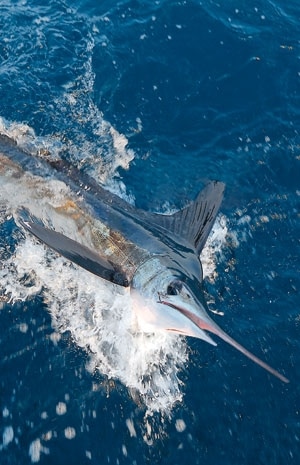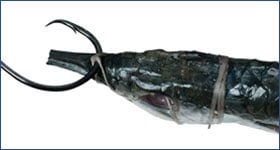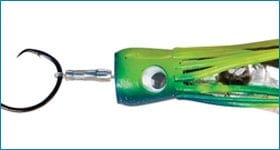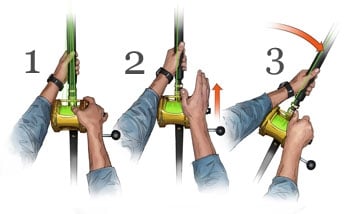
After we’d trolled the edge of the Gulf Stream all morning without a bite, I began to worry about the lures that we were dragging behind the boat. Instead of the traditional spread of ballyhoo and skirts common along the mid-Atlantic, I was watching a half-dozen big lures smoke and spurt across the surface of the water.
Ever since the National Marine Fisheries Service instituted rules requiring the use of non-offset circle hooks with natural baits in all marlin tournaments, mid-Atlantic anglers have been adapting their strategies and tactics. In tournaments, many have abandoned their favored rigs – spreads of dink baits, small ballyhoo and Ilander lures – in favor of the mandated natural baits rigged with a circle hook or artificials armed with a single J hook. Others have simply refined their artificial lure technique.
“For blue marlin,” says Capt. Rom Whitaker, “I think lures are the way to go.”
So lures work for blue marlin, but what about other species, like whites, sails, dolphin, wahoo and tuna?
That answer became clear when a psycho dolphin rocketed out of the water with one of Whitaker’s smaller lures stuck fast in the corner of its mouth. After a short fight and a quick gaff job, the green and gold fish was writhing on the deck of the boat.
Whitaker pulls his two biggest lures on the flat lines. The left-side lure rides just in front of the second boat wake, while the right-side lure is placed on the third wave. He pulls a big lure from each short rigger and a smaller lure from each long rigger. The short riggers are set to ride the face of the fourth wave, and the long-rigger lures go on the fifth wave. “I’ll even add another big lure down the center on the sixth or seventh wave,” he says. Whitaker also keeps a big Spanish mackerel rigged with a 12/0 circle hook in its nose to throw at any blue marlin that comes window shopping.
He rounds out the spread with a pair of big teasers. “I like something that splashes and throws a lot of water,” he says. He prefers a Black Bart Extreme Breakfast on one side and a plunger-style lure on the other. The teasers are set on the second wave behind the boat, opposite or slightly ahead of the flat-line lures.
Since he pulls lures fast, he covers more ground, a definite advantage when bites are few and far between.
Dinks and Circles
While white marlin, sails and spears will strike an artificial, anglers targeting these species usually use a circle hook lashed to the nose of a small ballyhoo.
I first began using circle hooks to target white marlin when I started fishing with Dr. Ken Neill, one of Virginia’s Master Anglers and a longtime advocate of the technique.


GALLERY: Skirted Ballyhoo Combo
Neill pulls both small naked ballyhoo and larger skirted ballyhoo in his trolling spread. He places a small ballyhoo on the flat lines and long riggers, while a larger ballyhoo and a Chugger or Ilander on the short rigger run outside and behind the teaser. A pair of artificial dredges are pulled off the stern cleats in the clear water, and a pair of squid chains from a teaser reel on the bridge ride outside and behind the dredge. The flat-line bait runs behind the dredge, next to the squid chain. “I want it to look like the flat-line bait is trying to catch up with the dredge,” he says. Finally, a naked ballyhoo on the long rigger follows 10 yards behind each short-rigger bait.
Neill always keeps a naked ballyhoo and a Spanish mackerel rigged as pitch baits. The V pattern of the trolling spread allows him to drop back a flat line or throw a suitable pitch bait to any fish that visits his teasers.
Blue Waters
For most mid-Atlantic anglers, the sticky point of the circle-hook rule came when they had to abandon their traditional Ilander and horse ballyhoo rig in tournament fishing. Before the rule change, the typical offshore arsenal consisted of dink baits for whites, sails, spears or dolphin and Ilander-ballyhoo combos for blue marlin, wahoo and tuna.
While rigging a dink bait with a circle hook is easy, rigging an Ilander with a circle hook is not. That’s because a circle hook is most effective when it is completely exposed, not buried in the belly of a bait.
Another problem is the nature of the beast. Unlike white marlin, which tend to play with their food first, blue marlin don’t mess around. “They come in and eat,” Neill says. That leaves an angler little time to react.
But those aiming for blues, whites, sails and spearfish, a mixed offshore bag, often need to employ a mixed spread to cover all the species.
To this end, marlin anglers have tried various techniques, from rigging an Ilander with a rubber ballyhoo and J hook to pulling artificials alongside rigged ballyhoo to relying on a pitch bait thrown at a big target that comes into the spread.
Neill has settled on a circle-hook rig with a horse ballyhoo behind a Mold Craft chugger. “We’ve caught blue marlin on a naked ballyhoo and a circle hook,” he says, “but they usually like something with a little more splash.”
Neill explains that using bigger baits also allows him to use bigger tackle: “We like to use 50s and 80s to target blue marlin, tuna and wahoo.”
When mid-Atlantic anglers deploy their baits, they don’t know whether they will encounter a bailer dolphin or a grander blue marlin. By using artificial lures rigged with a J hook and natural baits rigged with a circle hook, they can be ready for anything .
Setting the Hook

“Fishing with circle hooks is technique sensitive,” Neill says, explaining that getting the hook into the corner of the fish’s mouth is the hardest part of the process. “First, you have to beat the fish to the bait.”
Neill stresses that requires paying close attention.
When a marlin arrives behind a bait, Neill grabs the rod, keeps the tip high and waits for the fish to strike. (1) At the first bump, he drops the rod tip toward the fish, dumps the reel into free-spool and lets the fish have it. “Leave the clicker off, and don’t even put your thumb on the spool,” he says. “The bait has to fall freely, without any tension.”
While the fish is crushing the bait, turning it and swallowing it, Neill counts to five and continues to let out line. (2) When he feels like the marlin has had a chance to eat, he slowly pushes the drag lever forward and lets the line come tight. (3) Keeping the rod tip low, he cranks in line while sweeping the rod to drive the hook home.
Neill points out that the advantages of using circle hooks extend to the fish. “Research shows that circle hooks prevent deep hooking and post-release mortality,” he says, “so they’re good for the fish too.”









